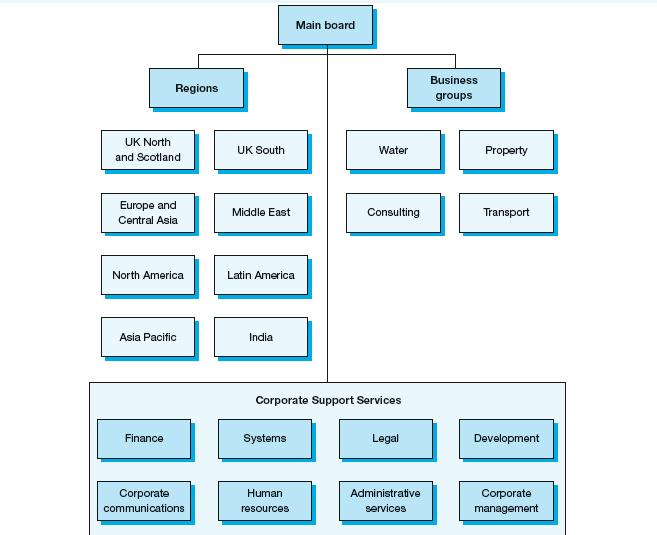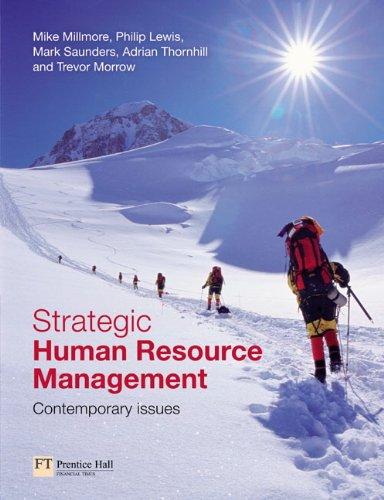Halcrow Group Limited is a multidisciplinary consultancy group specialising in the provision of planning, design and management
Question:
Halcrow Group Limited is a multidisciplinary consultancy group specialising in the provision of planning, design and management services for infrastructure development throughout the world. Within this, the Group’s main interests are transportation, water, property and consulting. Although Halcrow has a background in civil engineering and associated specialisms, in recent years the group has extended its range of disciplines to cover architecture, project management, environmental science, transport planning and other non-engineering but related skills.
Unlike many organisations, Halcrow does not have a mission statement, arguing that their ‘purpose … to sustain and improve the quality of people’s lives’
describes their approach better (Halcrow, 2003). This purpose is underpinned by a series of values which outline those things that are important to the Group:
‘Skills and innovation; Enjoying what we do; Delivering within time and budget’, codes of business behaviour and business principles.
Halcrow’s first projects outside the UK were undertaken in the 1890s, such work now accounting for nearly 40 per cent of an annual turnover in excess of £200 million with the Group currently undertaking projects in over 70 countries. Recent projects in which Halcrow have been involved include the Channel Tunnel Rail Link, road construction near the Stonehenge World Heritage Site, the International Congress Centre in Rome, Kuala Lumpur International Airport, new and refurbished stands for Chelsea Football Club, coordination of wetland conservation and river basin management for the Danube and its tributaries and managing pollution risk from the animal mass burial sites arising from the UK’s 2001 foot and mouth disease outbreak.
Halcrow was founded in 1868 by Thomas Meik, the company becoming Sir William Halcrow & Partners in 1941. In 1985 a private limited company bearing the same name was formed, the most recent change being in 1998, when the various Halcrow businesses and departments became Halcrow Group Limited. The Halcrow Trust owns 90 per cent of Halcrow, with the remaining 10 per cent by its employees. Halcrow has grown extensively over the past decade and now operates through a network of 29 UK and 32 international offices. As part of this growth, the number of employees has increased from 1,700 to nearly 5,000 worldwide. Approximately 80 per cent of Halcrow’s employees are classified by the Group as professional and technical
(P&T) staff who have a minimum of an undergraduate degree in engineering or a related subject. The majority are engineers who are also members of a relevant professional institution or are undergoing training to gain membership. The remaining 20 per cent of employees, including those in human resources, are classified by Halcrow as non-P&T and provide corporate support services.
Halcrow Group’s strategy As a result of restructuring to meet the future needs of the business environment, Halcrow’s operations were brought together in 2001 as four main business groups: Consulting, Property, Transport and Water. These operate as a matrix structure across the Group’s eight geographical regions, this structure facilitating appropriate employees or teams to be brought together for specific projects throughout the world (Figure 1). Each of the four business groups is led by a management team comprising five people including a Group board director or managing director.
Within each business group, P&T staff are assigned to technical skills groups the leader of whom is responsible for their training and career development. Employees are also assigned to an office in one of the regions. These vary in size from less than ten to more than 500 employees. The business groups and regional offices are supported by Corporate Support Services, comprising all the corporate and business support functions, including human resources, and located predominantly within the UK. At the time of writing, the human resource function had 31 employees divided between three teams: Personnel (22), Pensions (3) and Training (6)
with a director at the executive level.
Figure 1:

In 2004, Halcrow launched its change programme, ‘Act now’, which was designed to help the Group ‘to continue to develop in a dynamic and sustainable way’. The focus of ‘Act now’ was to align employees’ behaviours and approaches to Halcrow’s purpose, values, codes of behaviour and business principles thereby improving individual, team and overall business performance. This was summarised in Act Now: Your Pocket Guide to Halcrow’s Change Programme (Halcrow, 2004b: 8) as:
To take Halcrow’s existing personality, strengthen all those things that are good about it, for example, our …
• technical competence
• dependability
• friendliness
• reputation for being a safe pair of hands
• commitment
• pride in one’s profession
… and give it some added extras …
• passion
• dynamism
• fleetness of foot
• better listening skills
• excitement
• innovation
• confidence (with a clear sense of self)
• being more celebratory
• consistent delivery to expectation
• greater commercial edge
• being performance driven.
This change programme is intended to be continuous rather than having a specific end date. It emphasises the need for flexibility and the sharing of good practices and learning throughout the Group, the centrality of employees to achieving this, and the need to monitor and evaluate.
Questions
1. Provide a brief overview of Halcrow Group’s strategy.
2. Outline the linkages between Halcrow Group’s strategy and its strategic human resource management.
3. What obstacles do you think that Halcrow management will face as it works to change the Group’s culture from one dominated by technical excellence to one that also embraces commercial awareness?
4. What measures might Halcrow take to increase its retention of young professional graduates?
5.
(a) What hurdles do you think that Halcrow will have to overcome in its attempt to ensure international employees adopt the Group’s codes of behaviour?
(b) Now visit the Halcrow Group web site
(http:/www.halcrow.com) and read Halcrow’s Statement of Business Principles, paying particular attention to the Code of Business Practice. Expand your answer in the light of what this tells you about the Group’s views regarding business integrity, and what is expected of Halcrow staff.
6. To what extent do the data collected by the employee survey allow the HR director to evaluate the extent to which HR initiatives are supporting the Group’s strategic direction?
7.
(a) How does Halcrow currently make use of primary and secondary data to evaluate the extent to which initiatives to engage employees within the Group are working?
(b) What other measures do you think they might adopt?
Step by Step Answer:

Strategic Human Resource Management Contemporary Issues
ISBN: 9780273681632
1st Edition
Authors: Mark N. K. Saunders; Mike Millmore; Philip Lewis; Adrian Thornhill; Trevor Morrow





